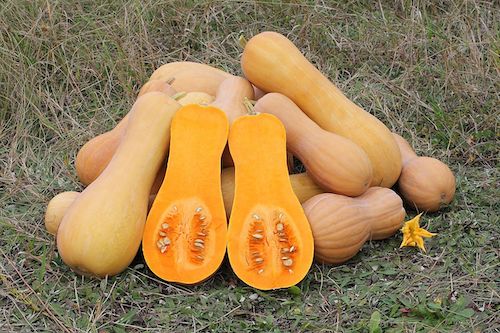Squash Hands — Butternut Squash Dermatitis
by Susan Stager, Fairfax Master Gardener
 Butternut Squash, Cucurbita moschata, is growing in the gardens, and we eagerly await butternut squash soup and roasted butternut squash in the fall.
Butternut Squash, Cucurbita moschata, is growing in the gardens, and we eagerly await butternut squash soup and roasted butternut squash in the fall.
You can buy it precut or frozen in the store today, with no waiting. You may wonder why the precut and frozen squash at the store is so expensive. If you’ve ever cut it up yourself, you will appreciate the work that goes into cutting this hard-skinned squash into manageable chunks and getting it ready to cook.
In addition, some people can have a skin reaction to cutting up and handling raw chunks of butternut squash. Hands become covered with a sticky, stiff, orange film that’s difficult to remove. Palms start feeling tight, red and crackly. Panic can set in, thinking you’re having a life-threatening reaction. In my case, I was able to remove it with a very stiff brush, and my hands returned to normal within an hour. Interestingly, it only reacts with skin, so there is no food allergy and it can be eaten.
The squash flesh beneath the hard rind has a protective sap, which fruits release when they’re wounded. The liquid that comes out when you cut squash, pumpkin and similar fruit is meant to essentially cauterize the area where it was “hurt” and dry it out, forming a layer to protect the fleshy insides. This sap contains an unidentified allergen present in squash — and other members of the Cucurbitaceae family, including pumpkins, acorn squash, cucumbers, melons, chayote and zucchini — that can result in this kind of contact dermatitis.

Squash Hands
You may have seen squashes with a scar of tiny teeth marks, where wildlife sampled the squash before it was ripe, and pulled out, once the irritation set in for them.
To prevent this irritation, wear food grade gloves, or buy precut butternut squash. Also, be sure to wait until the squash is ripe. Not everyone is sensitive to it, so you may be able to delegate the task.
Squash takes up a lot of room, but the smaller Honeybaby variety can be planted in containers in a small garden with a sturdy trellis. These squash weigh only 4 to 8 ounces and have a nutty sweet flavor. This hybrid squash is a great choice for the Southwest because of its powdery mildew resistance.
The species Cucurbita moschata squash includes cheese (flat shaped) and crookneck pumpkins, as well as butternut squashes. Butternut squash is a winter squash, meaning it is harvested late in the season to eat in the winter. It is categorized by the size of its fruit as a small winter squash, 1 to 4 pounds and with 80 to 100 days until harvest. By contrast, jumbo pumpkins are 50 to 100 pounds and have 120 days until harvest.
During the growing season, the blight green skin turns beige. Allow winter squash to ripen on the vine after the vine dries, so it can “cure” which means it develops a thick, hard rind so you can store it over the winter. Harvest before heavy frost, with 2 to 3 inches of the vine included, which also helps it store well. You can use it well into winter months from storage in a cool, dry place.
- References
- Hand Dermatitis Secondary to Exposure to Butternut Squash, National Library of Medicine
- Cucumbers, Melons, and Squash, Diane Relf and Alan McDaniel, Virginia Cooperative Extension
- Going Nuts about Butternut, How I Learned about Squash Hands, Peter Glatz, Illinois Times